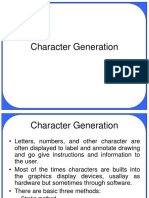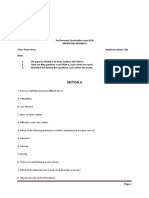To Implement Boundary Fill Algorithm
Uploaded by
SanjayLullaTo Implement Boundary Fill Algorithm
Uploaded by
SanjayLullaTo
Implement
Algorithm
Boundary
Fill
Boundary Fill is algorithm used for the purpose of coloring figures in
computer graphics. It is so similar to Flood Fill that many are confused as to
whether it is another variation of it. Here area gets colored with pixels of a
chosen color as boundary this giving the technique its name. One can see
the difference in the conditions that are there for planting the seeds.
Boundary fill fills the chosen area with a color until the given colored
boundary is found. This algorithm is also recursive in nature as the function
returns when the pixel to be colored is the boundary color or is already the
fill color.
If the boundary is specified in a single color, the fill algorithm proceeds
outward pixel-by-pixel until the boundary color is encountered. This is
called boundary fill algorithm.
4-Connected Region
Figure shows two methods for proceeding to neighbouring pixels from the
current test position. In the figure, four neighbouring points are tested.
The four neighbouring sides are refered as:
1.
2.
3.
4.
North
East
West
South
These are the pixel positions that are right, left above, and below the current
pixel. Areas filled by this method are called 4-connected. It is called 4-
connected because it is connected to 4 neighbouring regions of the current
pixel.
8-Connected Region
The second method, shown in figure is used to fill more complex figures.
Here the set of neighbouring positions to be tested includes the four
diagonal pixels. Fill methods using this approach are called 8-connected.
The eight neighbouring sides are refered as:
1.
2.
3.
4.
5.
6.
7.
8.
North
East
West
South
North-East
North-West
South-East
South-West
An 8-connected boundary fill algorithm would correctly fill the interior of
the area defined in figure but the 4 connected boundary fill algorithm
produces partial fill shown.
Algorithm for 4-connected boundary fill :
void boundaryFill4 (int x, int y, int fill, int boundary)
{
int current;
current = getPixel (x, y);
if ((current != boundary) && (current != fill))
{
setColor (fill);
setPixel (x, y);
boundaryFill4 (x+1, y, fill, boundary);
boundaryFill4 (x-1, y, fill, boundary);
boundaryFill4 (x, y+1, fill, boundary);
boundaryFill4 (x, y-1, fill, boundary);
}}
Algorithm for 8-connected boundary fill :
void boundaryFill8 (int x, int y, int fill, int boundary)
{
int current;
current = getPixel (x, y);
if ((current != boundary) && (current != fill))
{
setColor (fill);
setPixel (x, y);
boundaryFill8 (x+1, y, fill, boundary);
boundaryFill8 (x-1, y, fill, boundary);
boundaryFill8 (x, y+1, fill, boundary);
boundaryFill8 (x, y-1, fill, boundary);
boundaryFill8 (x+1, y+1, fill, boundary);
boundaryFill8 (x-1, y-1, fill, boundary);
boundaryFill8 (x-1, y+1, fill, boundary);
boundaryFill8 (x+1, y-1, fill, boundary);
}
}
Conclusion:
You might also like
- Stock Watson 3u Exercise Solutions Chapter 13 InstructorsNo ratings yetStock Watson 3u Exercise Solutions Chapter 13 Instructors15 pages
- p5 Notes Flood Fill Algorithm For Polygon FillingNo ratings yetp5 Notes Flood Fill Algorithm For Polygon Filling3 pages
- Terna Engineering College: LAB Manual Part ANo ratings yetTerna Engineering College: LAB Manual Part A10 pages
- CG-Practical 05 (Area Filling Algorithm-Boundary Fill, Flood Fill) 1No ratings yetCG-Practical 05 (Area Filling Algorithm-Boundary Fill, Flood Fill) 11 page
- Detecting Planar Homographies in An Image PairNo ratings yetDetecting Planar Homographies in An Image Pair6 pages
- Flood Fill: Flood Fill: Exploring Computer Vision's Dynamic TerrainFrom EverandFlood Fill: Flood Fill: Exploring Computer Vision's Dynamic TerrainNo ratings yet
- Patchmatch Stereo - Stereo Matching With Slanted Support WindowsNo ratings yetPatchmatch Stereo - Stereo Matching With Slanted Support Windows11 pages
- Fill area primitives to character generation'No ratings yetFill area primitives to character generation'19 pages
- A Review Polygon Filling Algorithms Using Inside-Outside Test PDFNo ratings yetA Review Polygon Filling Algorithms Using Inside-Outside Test PDF3 pages
- What Is A Bezier Curve?: Properties of Bezier CurvesNo ratings yetWhat Is A Bezier Curve?: Properties of Bezier Curves11 pages
- Visvesvaraya Technological University "Jnana Sangama", Belagavi - 590018No ratings yetVisvesvaraya Technological University "Jnana Sangama", Belagavi - 59001812 pages
- Parallel Hybrid Algorithm of Bisection and Newton-Raphson Methods To Find Non-Linear Equations RootsNo ratings yetParallel Hybrid Algorithm of Bisection and Newton-Raphson Methods To Find Non-Linear Equations Roots5 pages
- Image Textures: Simplex-Genetic ClassificationNo ratings yetImage Textures: Simplex-Genetic Classification5 pages
- Matching Gradient Descriptors With Topological Constraints To Characterise The Crowd DynamicsNo ratings yetMatching Gradient Descriptors With Topological Constraints To Characterise The Crowd Dynamics6 pages
- Bilinear Interpolation: Enhancing Image Resolution and Clarity through Bilinear InterpolationFrom EverandBilinear Interpolation: Enhancing Image Resolution and Clarity through Bilinear InterpolationNo ratings yet
- An Implementation of Path Planning Algorithms For Mobile Robots On A Grid Based MapNo ratings yetAn Implementation of Path Planning Algorithms For Mobile Robots On A Grid Based Map6 pages
- Seeded Region Growing Using Line Scan Algorithm - Stack Base ImplementationNo ratings yetSeeded Region Growing Using Line Scan Algorithm - Stack Base Implementation15 pages
- Fractal Image Compression by Local Search and Honey Bee Mating OptimizationNo ratings yetFractal Image Compression by Local Search and Honey Bee Mating Optimization6 pages
- Lab 01 Bisection Regula-Falsi and Newton-RaphsonNo ratings yetLab 01 Bisection Regula-Falsi and Newton-Raphson12 pages
- Quay Et Al (2022) Dewey's Education Through Occupations As Being-Doing-Knowing Creative Learning UnitsNo ratings yetQuay Et Al (2022) Dewey's Education Through Occupations As Being-Doing-Knowing Creative Learning Units17 pages
- For HDFC ERGO General Insurance Company LTDNo ratings yetFor HDFC ERGO General Insurance Company LTD2 pages
- Frictionless Spacecraft Simulator With Unrestricted Three Axis Movement For NanosatsNo ratings yetFrictionless Spacecraft Simulator With Unrestricted Three Axis Movement For Nanosats12 pages
- Ratio and Proportion Worksheets 7th Grade Worksheet 1No ratings yetRatio and Proportion Worksheets 7th Grade Worksheet 18 pages
- Candelaria MASTERLIST of Hybrid Model Farm (Per Cluster)No ratings yetCandelaria MASTERLIST of Hybrid Model Farm (Per Cluster)5 pages
- SAP Concur: The Complete Smart Solution For Your Business TravelNo ratings yetSAP Concur: The Complete Smart Solution For Your Business Travel1 page
- Performance-Related and Skill-Based Pay: An Introduction: ACT/EMP/17No ratings yetPerformance-Related and Skill-Based Pay: An Introduction: ACT/EMP/1744 pages
- Policy Clauses New India Mediclaim PolicyNo ratings yetPolicy Clauses New India Mediclaim Policy30 pages
- Stock Watson 3u Exercise Solutions Chapter 13 InstructorsStock Watson 3u Exercise Solutions Chapter 13 Instructors
- CG-Practical 05 (Area Filling Algorithm-Boundary Fill, Flood Fill) 1CG-Practical 05 (Area Filling Algorithm-Boundary Fill, Flood Fill) 1
- Flood Fill: Flood Fill: Exploring Computer Vision's Dynamic TerrainFrom EverandFlood Fill: Flood Fill: Exploring Computer Vision's Dynamic Terrain
- Patchmatch Stereo - Stereo Matching With Slanted Support WindowsPatchmatch Stereo - Stereo Matching With Slanted Support Windows
- A Review Polygon Filling Algorithms Using Inside-Outside Test PDFA Review Polygon Filling Algorithms Using Inside-Outside Test PDF
- What Is A Bezier Curve?: Properties of Bezier CurvesWhat Is A Bezier Curve?: Properties of Bezier Curves
- Visvesvaraya Technological University "Jnana Sangama", Belagavi - 590018Visvesvaraya Technological University "Jnana Sangama", Belagavi - 590018
- Parallel Hybrid Algorithm of Bisection and Newton-Raphson Methods To Find Non-Linear Equations RootsParallel Hybrid Algorithm of Bisection and Newton-Raphson Methods To Find Non-Linear Equations Roots
- Matching Gradient Descriptors With Topological Constraints To Characterise The Crowd DynamicsMatching Gradient Descriptors With Topological Constraints To Characterise The Crowd Dynamics
- Bilinear Interpolation: Enhancing Image Resolution and Clarity through Bilinear InterpolationFrom EverandBilinear Interpolation: Enhancing Image Resolution and Clarity through Bilinear Interpolation
- An Implementation of Path Planning Algorithms For Mobile Robots On A Grid Based MapAn Implementation of Path Planning Algorithms For Mobile Robots On A Grid Based Map
- Seeded Region Growing Using Line Scan Algorithm - Stack Base ImplementationSeeded Region Growing Using Line Scan Algorithm - Stack Base Implementation
- Fractal Image Compression by Local Search and Honey Bee Mating OptimizationFractal Image Compression by Local Search and Honey Bee Mating Optimization
- Quay Et Al (2022) Dewey's Education Through Occupations As Being-Doing-Knowing Creative Learning UnitsQuay Et Al (2022) Dewey's Education Through Occupations As Being-Doing-Knowing Creative Learning Units
- Frictionless Spacecraft Simulator With Unrestricted Three Axis Movement For NanosatsFrictionless Spacecraft Simulator With Unrestricted Three Axis Movement For Nanosats
- Ratio and Proportion Worksheets 7th Grade Worksheet 1Ratio and Proportion Worksheets 7th Grade Worksheet 1
- Candelaria MASTERLIST of Hybrid Model Farm (Per Cluster)Candelaria MASTERLIST of Hybrid Model Farm (Per Cluster)
- SAP Concur: The Complete Smart Solution For Your Business TravelSAP Concur: The Complete Smart Solution For Your Business Travel
- Performance-Related and Skill-Based Pay: An Introduction: ACT/EMP/17Performance-Related and Skill-Based Pay: An Introduction: ACT/EMP/17

























































































